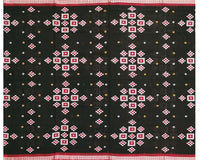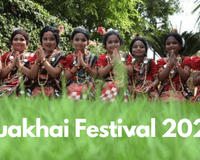
Kalahandi (locally pronounced Kalahani) is a district of Odisha in India. The region had a glorious past and great civilisation in ancient time. Archaeological evidence of stone age and Iron Age human settlement has been recovered from the region.Asurgarh offered an advanced, well civilised, cultured and urban human settlement about 2000 years ago in the region.In South Asia it is believed that the lands of Kalahandi district and Koraput district were the ancient places where people started cultivation of paddy. In ancient time it was known as Mahakantara (meaning Great Forest) and Karunda Mandal, which means treasure of precious stones like karandam (Corundum/Manik), Garnet (red stone), Beruz, Neelam (Sapphire/blue stone), and Alexandra etc. Manikeswari (the goddess of Manikya or Karandam) is the clan deity of Kalahandi may also signify its historical name.
History:-
Kalahandi region had a glorious past and great civilisation in ancient time. Archaeological record of 'Tel valley' reveals the presence of the primates in its zones during the Pleistocenephase. Paleolithic is being documented in Kalahandi, like Moter river basin in Dharamgarh region.One of the largest size axe of late stone age culture has been recovered from Kalahandi. Tel river civilisation put light towards a great civilisation existing in Kalahandi in the past that is recently getting explored.The discovered archaeological wealth of Tel Valley suggest a well civilised, urbanised, cultured people inhabited on this land mass around 2000 years ago and Asurgarh was its capital. Kalahandi along with Koraput and Bastar was part of Kantara referred in Ramayana and Mahabharata.In 4th century B.C. Kalahandi region was known as Indravana from where precious gem-stones and diamond were collected for the imperial Maurya treasury.During the period of Maurya emperor Ashoka, Kalahandi along with Koraput and Bastar region was called Atavi Land.This land was unconquered as per Ashokan record.In the beginning of Christian era probably it was known as Mahavana.In 4th Century A.D. Vyaghraraja was ruling over Mahakantara comprising Kalahandi, undivided Koraput and Bastar region.Asurgarh was capital of Mahakantara. After Vyaghraraja, the Nala kings like Bhavadatta Varman, Arthapati and Skanda Varman ruled over south part of this region up to about 500, the territory was known as Nalavadi-visaya[15] and rest of Mahakantara, lower part of Tel river valley was ruled by king Tastikara and his scions, the kingdom was known as Parvatad-waraka, whose headquarters was Talabhamraka near Belkhandi.In the 6th century a new kingdom developed in the Kalahandi tract under King Tustikara, but very little is known about other kings of his family. Maraguda valley was identified as capital of Sarabapuriyas. During Sarabapuriyas in the 6th century, Kalahandi lost its political entities and merged with eastern part of South Kosal or Kosal. But this was also for a short period as in succeeding phase it assumed a distinct name Trikalinga. By the 9th–10th centuries the region including Western Odisha, Kalahandi, Koraput and Bastar was known as Trikalinga. The Somavamsi king Mahabhavagupta I Janmejaya (925 – 960) assumed the title Trikalingadhipati.Trikalinga was short lived and Chindakangas carved out a new kingdom called Chakrakota Mandala or Bramarakota Mandala, which later one expanded to whole Kalahandi and Koraput.
The Naga dynasty started ruling Kalahandi in 1006. The Nagas of Kalahandi are the only dynasty in Odisha having a record of thousand years (1050–1948). During the 12th century Chkrakota Mandal was incorporated with the Ganga realm of Kalinga, and renamed "Kamala Mandala", thus Kalahandi region became part of Kalinga as a feudatory of the Eastern Gangas under Nagas rules and continued till 14th century. After 14th century Nagas owed allegiance from Eastern Gangas to the Suryavamsi Gajapatis. This territory assumed independence after the downfall of the Gajapatis of Odisha in 1568. According to tradition the Kalahandi kingdom commanded sovereign power over eighteen garbs. It was occupied by the Bhonslas of Nagpur in the middle of the 18th century but still it was a Gadajat under Nagas rule. In 1853 the Nagpur state lapsed to the British Crown as Raghujee III died without an heir. Then Kalahandi became a princely state under British and known as Karonda Mandal. Maharaja Pratap Keshari Deo, the Ex-Maharaja of Kalahandi, in one of his articles expressed his view that the historical significance of naming Kalahandi as Karunda Mandala is based on the availability of Corundum in this region. Manikeswari (the goddess of Manikya), the clan deity of the Naga kings of Kalahandi may have also necessitated the adoption of the name.
After Indian independence, Kalahandi joined with the Union of India on 1 January 1948. On 1 November 1949, Patna Balangir district and Subarnapur district together constituted a separate district and the Nuapada sub-division of Sambalpur was added to the Kalahandi district. In 1967, Kashipur block of Kalahandi district was transferred to Rayagada division for administrative purpose. In 1993, Nuapada sub-division was carved out as a separate district, but Kalahandi (Lok Sabha constituency) continues to constitute present Kalahandi district and Nuapada district together.
ROAD AND TRANSPORT:-
The nearest airport is in Raipur (200–250 km) having daily flights to majority of the cities in India. Kalahandi can be reached from Raipur via Nuapada or Dharamgarh. Vishakhapatnam airport is 300 km away and Bhubaneswar airport in 450 km. Kesinga is the gateway of Kalahandi for rail connectivity. It is directly linked with most of the major cities in India, such as Delhi, Chennai, Kolkata, Bangalore, Hyderabad, Ranchi, Bhubaneswar, Visakhapatnam, Raipur, Nagpur, Ahemadabad etc. by rail. A new railway station for Bhawanipatna has been opened for service and was inaugurated on 11 Aug 2012.National Highway 201 and 217 pass through Kalahandi. Luxury night buses are available to Bhubaneswar, Cuttack, Raipur, Visakhapatnam, Sambalpur and Rourkela from Kalahandi.
CULTURE AND TRADITION:-
Kalahandi is a rich land in culture and festivals.Since it is a melting point of southern Odisha and Western Odisha with a substantial tribal population, those living in hills as well as plain land, their culture, tradition, languages and belief along with mainstream Hindu culture have made Kalahandi region rich with culture and festivals. The mixture of Aryan and tribal culture makes Kalahandi region rich in its culture and festivals. In pre-independence period Kalahandi was largely inspired to Saivaism, Vaishanivism and Shakti puja. Shakti Puja is largely accepted among tribal, perhaps due to which Kalahandi was well known for celebrating Shati Puja. However, affect induction of Kalahandi as part of Odisha state, dominance of coastal Oriya culture in the state is increasingly influencing the local culture. Celebration of Rathajatra and construction of Jaggannath temple in Kalahandi has been increasingly realised unlike in old days of Radha Krishna temple.
Local custom
The majority of the population are Hindu, a small minority being Christian, Muslim, Sikh, Buddhist and Jain. 28% of the population are tribal people which has the majority of the impact on the local customaries and influenced the dialect.
Art & craft
Literally 'Kalahandi' means 'pot of arts'. This name has been possibly derived from "Gudahandi Caves" containing pre-historic paintings in red and black colours. Kalahandi is a rich land in terms of art and craft. Stone from Kalahandi is well known to make jewellery. Habasipuri pattern is well established in handloom Saree. Wood craft from Khaipadar is famous for export and domestic market.
Dance & music
Kalahandi has the wide varieties of dance forms comprising tribal and non-tribal dance. Among the districts level in Odisha, it has the maximum dance form. Overall Kalahandi life is associated with music and dance. Some of the dance found in Kalahandi such as Dalkhai, Jaiphula, Rasarkeli, Sajani etc. have similarities with the dance form in Balangir, Sambalpur, etc. regions whereas Sari song, Pholia song, song related to nature etc. has similarities with Koraput region. However, Boria song, Nialimali, Kalakolik etc. mostly found in Kalahandi. On the other hand, Ghumura, Madali, Dandari, Dhab, Bajasalia etc. folk form found in Kalahandi can be composed songs.
Festivals:-
Popular Hindu festivals
- Dasra (Dasara): Dasara or Durga Puja is celebrated among Hindu all over India, but it is very popular in Eastern part of India including West Bengal, Odisha, Assam etc. However, goddess Durga is known as Shaki (Energy) and most of the goddess based on tribal and Shaki is inspired from goddess Durga. The major goddess of Kalahandi including Manikeswari, Lankeswari, Denteswari, Khameswari, Bhandargharen etc. are seen as a reflection of goddess Durga and most of the major festivals like Chhatar Jatra, Kkandabasha, Budharaja Jatra, etc. are celebrated during Dusra. Dusra is significant in all the Skati Pitha in Kalahandi and is one of the popular festival in the region.
- Diel or Deepawali: Also popularly known as Diwali is celebrated in Kalahandi. But this is getting popular due to immigrant business community mainly from Marwadi community, however, slowly it has entered the local stream.
- Rathajatra: The festival of Rathjatra is inspired from Rathajatra in Puri. Since independence when Kalahandi became part of Odisha state the dominance of coastal Oriya culture has influenced Kalahandi. Number of new Jagganath temples have come over Kalahandi since 1950 and celebration of Rathajatra is increasing realised. This is also boosted by immigrant business community and Government officials from coastal Odisha and Berhampur region.
- Shivaratri:
- Holi:
- Janmastami:
- Ramnabami:
Local specials[edit]
- Chhatar Jatra: The festival is celebrated in Bhawanipatna
- Khandabasa: The festival is celebrated in Junagarh in the Lankeswari Temple.
- Nuakhai:
Manikeswari is one of the popular Hindu deity in Orissa. There are many Manikeswari temples present in Western and Southern part of Orissa.
Manikeswari temple in Bhawanipatna is well recognized in Orissa. Manikeswari is also the primary deity associated with the royal family of Paralakhemundi in Gajapati. Chhatar Jatra is one of the most popoular festival of Manikeswari at Bhawanipatna. Khandasadhaka is a festival associated with Manikeswari in Paralakhemundi.
Situated on the confluence of the river Tel and Uttei, two tributaries of the river Mahanadi, Belkhandi has gained prominence as a centre of religious activities and archaeological importance with a picture-sque site. Besides the temples now standing therein, ruuins of 12th Century monuments have been excavated from there in the recent past.
Fifteen Kilometres from Bhawanipatna, Phurlijharan is a perennial water fall about 30 Ft in height and has a special charm of its own. Themulti coloured rainbow created by the sunrays falling on the scattered water particles of the fall is an amusing sight to be seen. The evergreen forests around the fall provide ample opportunities to group picnickers.
Kalahandi is one of the famous historical and ancient places of India or Odisha; where Dokarichanchara is a picnic or tourist place located in the village Kokasara, on the border of Kalahandi and Nabarangpur district. It is completely different and unique place than that of other attractive tourist centers in Kalahandi.
77 K.Ms from Bhawanipatna the picturesque Ampani hills present a panoramic view of nature. A frolicking vally called "Haladigundi" in thishill range exhibits some peculiar features due to the reflected rays on the sun.
In the morning and evening the objects of vision appear yellow. The whole area abounds in spotted deer, Sambar and Black Panthers who can be seen at the Behera reservoir. 5 K.Ms away are the pre-historic cave paintings at Gudahandi.
Economy:-
According to the 2011 census Kalahandi district has a population of 1,573,054,equal to the nation of Gabon or the US state of Idaho.This gives it a ranking of 317th in India (out of a total of 640). The district has a population density of 199 inhabitants per square kilometre (520/sq mi) . Its population growth rate over the decade 2001–2011 was 17.79%.Kalahandi has a sex ratio of 1003 females for every 1000 males, and a literacy rate of 59.22%.
References:-
1:-https://en.wikipedia.org/wiki/Kalahandi_district
2:-http://www.nuaodisha.com/Odisha-Tourism/Tourist-Places-in-Kalahandi.htm









1 comment
LINGARAJ MISHRA
Read with pleasure.
Ancient literature and linguistic traditions should be a part of the study report